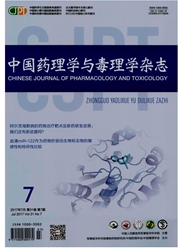

 中文摘要:
中文摘要:
目的在体外帕金森病(Parkinson's disease,PD)模型观察低剂量鱼藤酮诱导的BV2小胶质细胞白介素6(IL-6)生成及montelukast的作用。方法以PD诱导因子鱼藤酮处理小鼠小胶质细胞系BV2细胞。Western blot方法检测BV2细胞前炎症细胞因子IL-6蛋白表达,ELISA方法检测BV2细胞IL-6释放。观察Cys LT1R拮抗剂montelukast对鱼藤酮诱导的小胶质细胞IL-6的影响。结果低剂量鱼藤酮(0.3~3 n M)浓度依赖性地增加IL-6蛋白表达;以鱼藤酮(3 n M)处理细胞1~24h,时间依赖性的诱导IL-6释放增加。Cys LT1R拮抗剂montelukast降低鱼藤酮增高的BV2细胞IL-6水平。结论低剂量鱼藤酮诱导小胶质细胞前炎症细胞因子IL-6增加,montelukast抑制鱼藤酮诱导BV2细胞效应。
 英文摘要:
英文摘要:
Objective To understand low-dose rotenone-induced interleukin-6( IL-6) production and the effect of montelukast in an in vitro model of Parkinson's disease( PD). Method BV-2 cells,an immortalized cell line of murine microglial cells,were treated with PD inducer rotenone. The expression of proinflammatory cytokine( IL-6) protein was detected with Western blot,and the level of IL-6 in the supernatants was analyzed by ELISA. The effect of Cys LT1 R antagonist montelukast on rotenone-induced microglial IL-6 production was investigated. Findings Treatment with low-dose rotenone( 0. 3- 3 n M) dose-dependently increased cytokine IL-6 expression in BV2 cells. Exposure to( 3 n M) rotenone for 1- 24 h induced IL-6 release from BV2 cells in a time-dependent manner. Cys LT1 R antagonist montelukast( 0. 1 and 1μM) significantly reduced IL-6 production in rotenone( 3 n M)-treated BV2 cells. Conclusion Low-dose rotenone can induce microglial proinflammatory cytokine IL-6 production. Montelukast can effectively inhibit low-dose rotenone-induced microglial response.
 同期刊论文项目
同期刊论文项目
 同项目期刊论文
同项目期刊论文
 期刊信息
期刊信息
